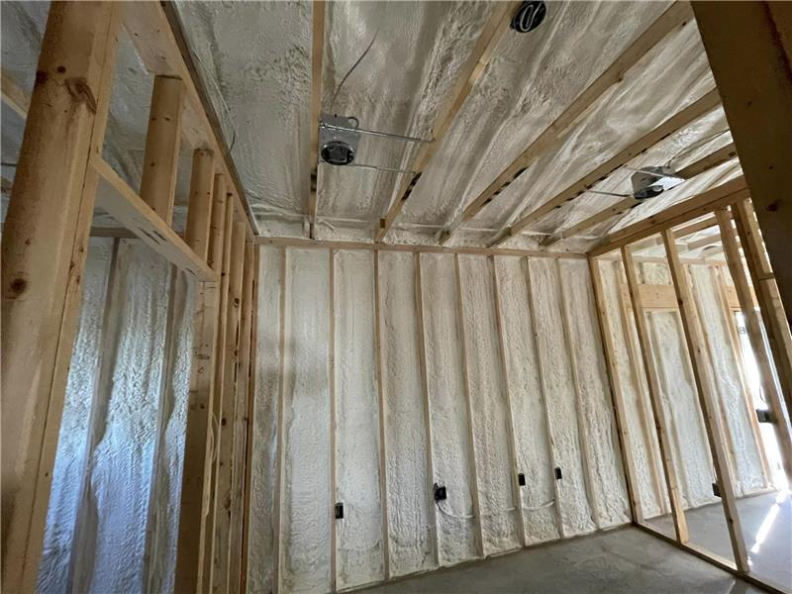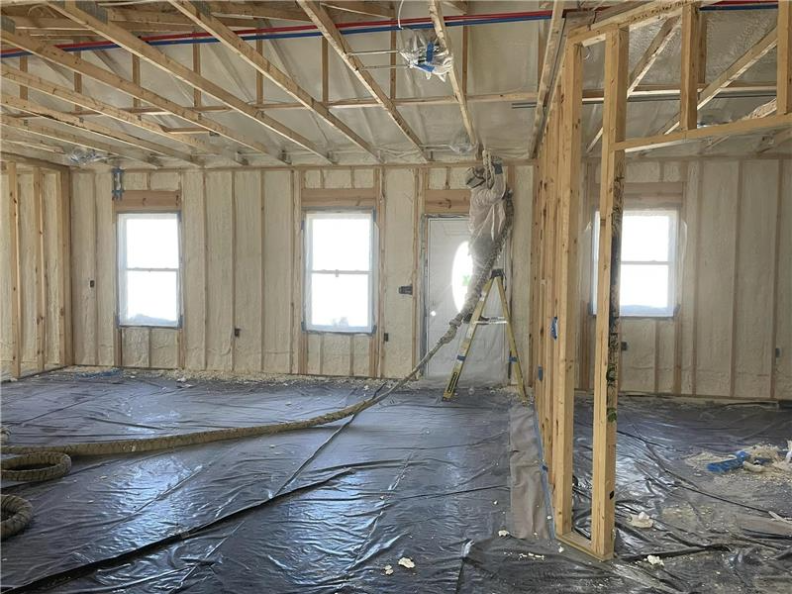
Spray foam insulation effectively prevents mold growth and moisture infiltration when properly installed by creating an impermeable barrier that eliminates the three conditions mold requires: moisture, organic material, and oxygen access. Closed-cell spray foam provides superior moisture resistance with its closed cellular structure, while open-cell foam offers excellent air sealing that reduces humidity infiltration.
The material’s expanding properties fill microscopic gaps and cracks where traditional insulation fails, creating continuous protection against water vapor transmission and air leakage. This comprehensive sealing eliminates condensation points within wall cavities and attic spaces where mold typically develops in conventional insulation systems.
Closed-cell spray foam functions as both insulation and vapor barrier, achieving permeability ratings below 1.0 perms when applied at proper thickness. This low permeability prevents water vapor from penetrating building envelopes, eliminating the primary moisture source that feeds mold growth.
The chemical composition of polyurethane foam creates hydrophobic properties that actively repel liquid water while maintaining structural integrity in wet conditions. Unlike cellulose or fiberglass materials that absorb moisture and create ideal mold breeding environments, spray foam maintains its protective qualities when exposed to humidity.
| Foam Type | Permeability Rating | Moisture Absorption | Air Leakage Control | Mold Prevention Effectiveness |
|---|---|---|---|---|
| Closed-Cell Spray Foam | 0.2-1.0 perms | Minimal | Excellent | Superior |
| Open-Cell Spray Foam | 3.0-5.0 perms | Low | Excellent | Very Good |
| Fiberglass Batts | 30+ perms | High | Poor | Minimal |
| Cellulose | 20+ perms | Very High | Fair | Poor |
Bonus Tip: Apply closed-cell spray foam at minimum 2-inch thickness to achieve optimal vapor barrier performance. Thinner applications may not provide adequate moisture protection in high-humidity environments.
Crawl spaces benefit significantly from closed-cell spray foam application due to ground moisture exposure and limited ventilation. The material’s ability to adhere directly to concrete and masonry surfaces creates seamless protection against rising damp and exterior moisture infiltration.
Basement installations require careful attention to below-grade moisture sources and hydrostatic pressure considerations. Spray foam applied to interior foundation walls prevents condensation while allowing concrete to dry inward, eliminating trapped moisture that feeds mold growth.
Bonus Tip: Address existing moisture sources before spray foam installation. Foundation leaks, plumbing issues, and exterior drainage problems must be resolved to ensure long-term effectiveness.
Attic applications focus on preventing warm, humid air from reaching cold surfaces where condensation occurs. Spray foam creates thermal barriers that eliminate temperature differentials responsible for moisture accumulation on roof decking and structural members.
Exterior wall cavities in older construction often lack proper vapor control, creating ideal conditions for mold development. Spray foam retrofits eliminate these moisture pathways while improving overall building envelope performance.
Independent testing by the Oak Ridge National Laboratory demonstrates that closed-cell spray foam reduces air infiltration by 85-95% compared to traditional insulation methods. This dramatic reduction in air movement directly correlates with moisture control effectiveness.
Building science research indicates that structures with spray foam insulation maintain indoor humidity levels 15-25% lower than conventionally insulated buildings during high-humidity periods. This consistent humidity control prevents the fluctuating conditions that promote mold growth cycles.
Long-term performance studies spanning 20+ years show no mold growth in properly installed spray foam systems, even in challenging environments like coastal regions and humid subtropical climates. This track record demonstrates the material’s reliability for moisture management applications.

Surface preparation significantly impacts spray foam’s moisture control effectiveness. Surfaces must be clean, dry, and free from existing mold contamination before application to ensure proper adhesion and long-term performance.
Installation temperature and humidity conditions affect foam expansion and curing characteristics. Professional installers monitor environmental conditions to optimize cellular structure development and final moisture resistance properties.
Proper thickness application ensures adequate vapor barrier performance and structural integrity. Insufficient thickness compromises moisture control capabilities, while excessive application may create adhesion problems or dimensional instability.
Existing moisture problems require resolution before spray foam application to prevent trapped moisture and continued mold growth. Professional moisture assessment identifies hidden problems that could compromise installation effectiveness.
Building ventilation systems may require adjustment after spray foam installation due to reduced natural air exchange. Mechanical ventilation ensures adequate indoor air quality while maintaining moisture control benefits.
Climate zone considerations influence foam type selection and application techniques. High-humidity regions benefit from closed-cell applications, while moderate climates may achieve adequate protection with open-cell systems.
Code compliance requirements vary by jurisdiction and application area. Local building officials may specify vapor barrier requirements, fire ratings, and installation standards that affect material selection and application methods.
Closed-cell foam provides superior moisture resistance for high-risk applications like basements and crawl spaces. Open-cell foam offers adequate protection for above-grade applications with lower moisture exposure risk.
Active water leaks, high moisture content in building materials, and inadequate drainage require correction before foam application. These conditions must be addressed to ensure long-term mold prevention effectiveness.
Older buildings often lack proper vapor control and may require closed-cell foam for comprehensive moisture management. Newer construction with existing vapor barriers may achieve adequate protection with open-cell applications.
Ozark Eco Foam specializes in comprehensive moisture management applications designed to eliminate mold growth conditions in residential and commercial buildings. Professional assessment identifies optimal foam types and application strategies for specific moisture challenges.
Spray foam insulation provides proven protection against mold growth and moisture infiltration when properly selected and professionally installed. The material’s unique properties address root causes of moisture problems rather than simply treating symptoms.
Evaluate your building’s specific moisture risks, existing conditions, and long-term protection requirements when considering spray foam applications. Professional assessment ensures optimal material selection and installation techniques for maximum mold prevention effectiveness.
Eliminate mold risks and moisture problems with professional spray foam installation tailored to your building’s specific requirements. Ozark Eco Foam provides comprehensive moisture assessment and proven installation techniques that deliver lasting protection.
Contact Ozark Eco Foam at (417) 572-5893 or ozarkecofoam@gmail.com for professional evaluation of your moisture control needs. Expert assessment identifies optimal solutions for your specific building conditions and moisture challenges.
Properly installed spray foam maintains mold prevention effectiveness for 25-30+ years without degradation. The inorganic composition resists breakdown and continues blocking moisture infiltration throughout its service life.
Spray foam prevents future mold growth but cannot eliminate existing contamination. Professional mold remediation must occur before foam installation to ensure complete problem resolution and prevent trapped contamination.
Closed-cell spray foam prevents moisture penetration when properly installed at adequate thickness. However, building envelope failures like roof leaks require immediate repair to prevent moisture accumulation behind any insulation system.
Spray foam provides effective moisture control in all climate zones when properly selected and installed. High-humidity regions benefit from closed-cell applications, while moderate climates achieve adequate protection with open-cell systems.
Spray foam requires minimal maintenance for moisture control effectiveness. Regular building envelope inspections identify potential problems before they compromise the foam barrier’s integrity and performance.